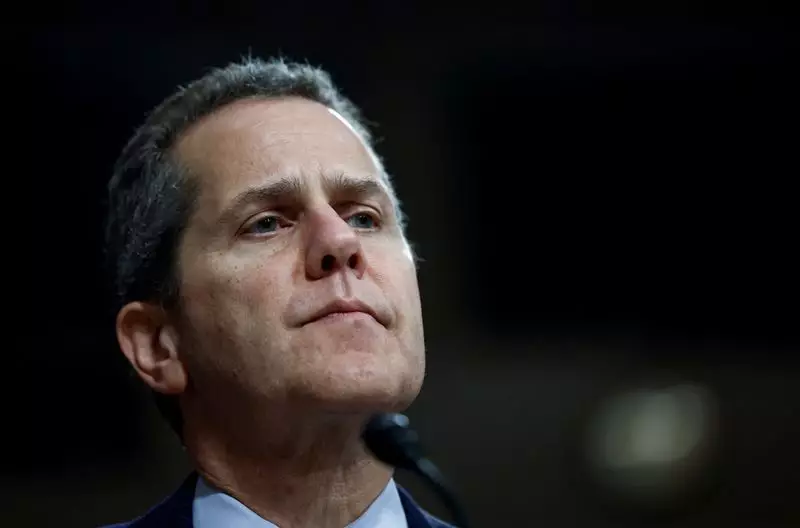The recent announcement of Michael Barr’s pending departure as the Federal Reserve’s Vice Chair for Supervision represents a significant pivot point in U.S. banking regulation. Set to leave his role on February 28, Barr avoids a potentially contentious confrontation with incoming President Donald Trump, who is now primed to reshape the regulatory environment in a way that aligns with his administration’s priorities. Amid growing concerns about regulatory oversight and financial stability, Barr’s exit opens the door for a shift toward a more industry-friendly agenda under the upcoming administration.
Barr’s departure, while noted to be a personal decision, underscores the pressures he faced amid an evolving political landscape. Initially appointed by President Joe Biden, Barr’s tenure was marked by efforts to enforce stricter regulations on large financial institutions. His strategic initiatives, aimed at increasing capital requirements and enhancing risk assessments under the so-called “Basel III Endgame,” faced significant pushback from the banking sector. The industry viewed these measures as burdensome, potentially stifling their operational flexibility. As such, his resignation not only signals a pivot toward a relaxed regulatory stance but also indicates Bar’s recognition of the challenges posed by the incoming administration.
Trump’s opportunity to appoint a new regulatory chief presents him with a chance to install an official who may prioritize the interests of the financial sector over strict enforcement. This development aligns with Trump’s historical skepticism toward regulation, promoting a narrative of deregulation that resonates with his political base.
With Barr’s announcement, attention now turns to who might succeed him. Notable candidates include Fed Governor Michelle Bowman, who has openly criticized Barr’s regulatory ambitions, and Christopher Waller, another appointee from Trump’s first term. However, the intricacies of the Federal Reserve’s governance complicate matters. Currently, the Fed’s board is not open to new appointments until 2026, potentially forcing Trump to either promote from within or creatively maneuver current personnel to establish a vacancy.
Experts speculate that any rapid moves to install a new regulatory chief may be bogged down by the need for Senate confirmations, indicating that any immediate shift in policy might be slow to materialize. Despite the clear intent to favor a deregulatory agenda, Barr’s continued presence on the Fed’s Board of Governors may serve as a counterbalance, retaining Democratic influence within the institution until his term expires in 2026.
The news of Barr’s resignation elicited a rally in bank stock prices, pointing to the immediate market belief that a change in leadership could lead to a less restrictive regulatory environment. Major banks, including Citigroup and Bank of America, witnessed notable upticks in their stock values, signaling investor optimism about potential deregulation.
While the market’s response underscores the growing belief that financial institutions will face fewer obstacles in their operational pursuits, it also raises questions about the long-term implications for financial system stability. Reduced oversight could lead to an increase in risk-taking by banks, potentially exacerbating systemic vulnerabilities reminiscent of past financial crises.
A Balancing Act: The Federal Reserve’s Independence
One critical point arising from Barr’s exit is the debate over the independence of the Federal Reserve. The incoming Trump administration’s intent to exert greater influence over the central bank is concerning for many observers who argue the necessity of maintaining the institution’s autonomy to effectively set monetary policy. Suggestions of increased White House influence paint a picture of a Fed that might prioritize political expediency over prudent risk management.
Fed Chair Jerome Powell’s reaffirmation that he intends to serve out his term, amidst speculation about his job security under a Trump presidency, adds another layer of complexity to the evolving dynamics. The legal parameters surrounding the dismissal or demotion of Fed officials remain unclear, yet the implications for central bank independence cannot be understated.
As the Federal Reserve embarks on this significant transition, the ramifications of Barr’s resignation are set to reverberate throughout the financial sector. Navigating the tension between regulatory enforcement and industry-friendly policies will be paramount for the incoming administration. The financial community, investors, and policymakers alike must remain acutely aware of the shifts in supervisory philosophy and the inherent risks that could arise. As the landscape evolves, the balance struck between regulatory oversight and economic growth will be crucial in shaping the future of the U.S. banking system.

